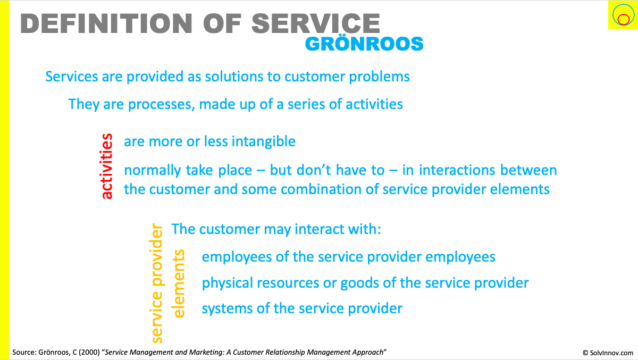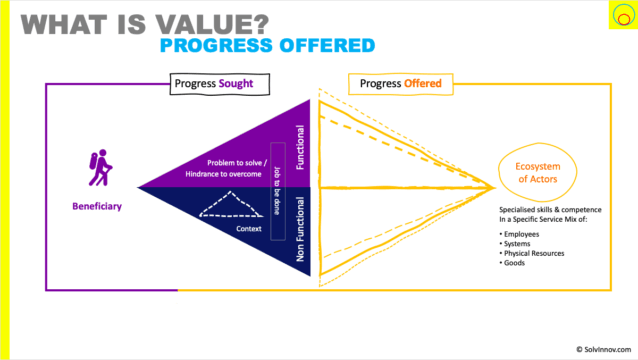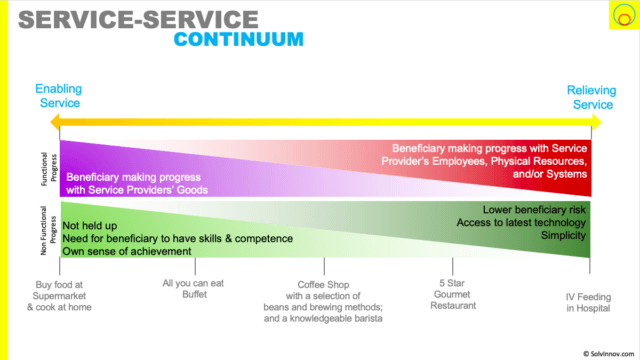The Big Picture…
As we take an evolved view of the world – where beneficiaries are trying to make progress in aspects of their life – we find ourselves in a service-first world. And since everything is a service, the oft used goods-services continuum – between tangible and intangible – no longer makes sense.
However, we do observe a service-service continuum between what Bettencourt, Vargo & Lush have called enabling and relieving services.
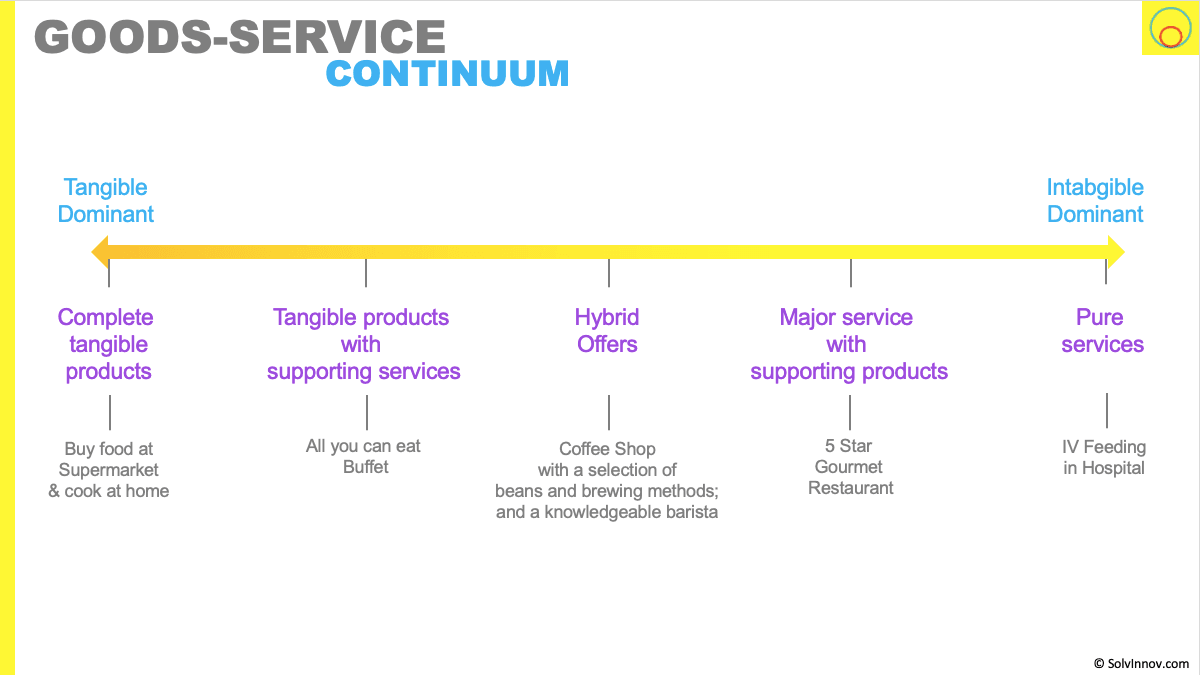
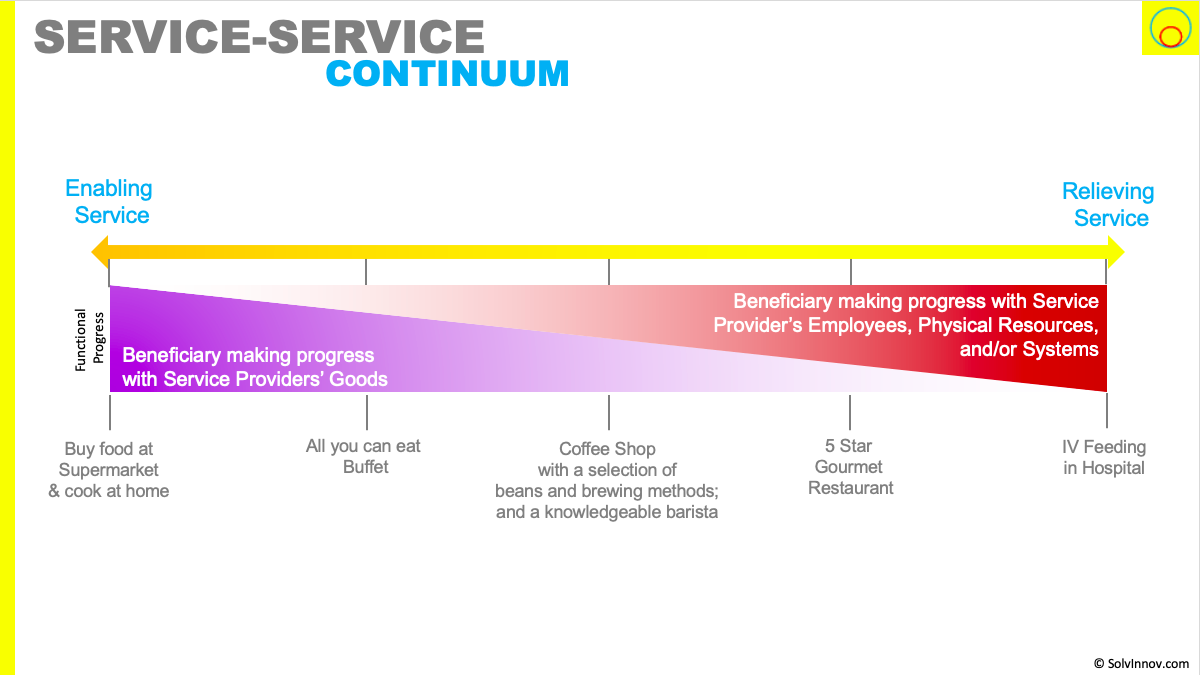
Where an enabling service‘s service mix tends toward goods. And the beneficiary is the co-executor of the service. Which in the strongest case can be seen as self-service. Whereas we find more of the other components of the service mix (employees, systems, physical resources) in a relieving service‘s service mix . And, in this case, the beneficiary will generally be “consuming” rather than co-executing.
Implications
Whilst our first question in innovation should always be “what progress am I trying to help a beneficiary make”. Now we can add ”how would the beneficiary like to be helped?”. What balance of enable/relieve is the market looking for?
And there are implications for that choice. For example, enabling likely leads to fewer hold-ups. But requires the beneficiary to bring more skills and competence to the co-creation of value – which we may need to help them acquire.
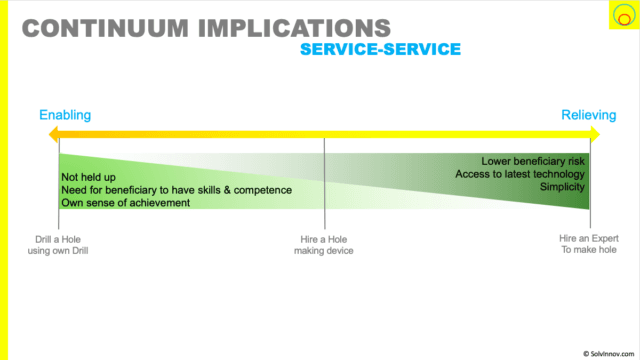
Whereas, a relieving service lowers beneficiary risk, is often “simpler” for them, and can offer access to the latest technology refreshes. But it reduces own sense of achievement – which may be an element of progress the beneficiary is seeking. And relieving service might need scheduling, which could entail hold-ups depending on availability.
These are all aspects of non-functional progress. And those aspects of non-functional progress – safely, independently, availability, simplicity, sense of achievement etc – help position you in the innovation space and along the service-service continuum. Accessing this perspective is more obvious on the service-service continuum than the goods-service continuum.
The Idea
When we think in traditional terms about goods and service, we end up observing the traditional goods-service continuum. Where we appreciate that some goods (tangibles) come with supporting services. And some services (intangibles) come with supporting products. As in Figure 1.
For example, we might buy food at a supermarket, go home and cook it for an evening meal. This is at the tangible dominant end of the continuum. We are dealing with goods – the food items. (Well, OK, you could argue that the supermarket and distributors have provided a service, but let’s keep the example simple. You bought some goods and used them)
At lunchtime, though, you might have gone to an all you can eat buffet. You’re still mostly interested in the goods – this time the range of food on offer. But there’s a few services supporting the buffet. A cook has prepared the dishes. And a waiter has probably seated you and may have cleaned the table after previous guest so it was clean for you. We’ve shifted a little to the right on the continuum.
Tomorrow night you might be off to a 5-star restaurant with friends. Clearly there is still food (tangibles) involved. But now you’re mainly there for the experience and skills of the chef, waiting team and restauranteur. It’s a major service with supporting products.
And such a continuum leads us to concepts such as servitisation – wrapping goods up in service(s) in an attempt to find growth. As well as fitting into the narrative of there being some kind of goods vs service discussion.
This goods-service continuum works nicely in a world where we see a clear distinction between goods and service. However, that’s not where we need to be (or are).
Our Service Evolution
Over in my article on what is service I said we should not consider a world dominated by goods and then try and fit in service. Rather we should consider a service-first world, and see how goods fit in. That thinking leads to Grönroos’ definition of service. Which you can see again in Figure 2.
Now we see that goods are just one of the service provider elements a beneficiary can interact with during a service. Along with employees, physical resources and systems. I call this the service mix.
We can draw a distinction in how the elements are used. Goods are mainly used in acts of self service. Cooking our own meal, for example is self service. Or we could buy (or already own) a drill and use it to make a hole in the wall to hang up a picture. Whereas the beneficiary using employees is not self-service.
What about using service provider’s systems? Well, that could be in an act of self-service. Think of online banking for example. Or it could be as part of a fuller service. Here we can think of those telephone menus we have to navigate to get to speak to a real human. Or the Uber app to summon a car. And the system might be a bot/AI agent fulfilling the role of an employee.
Similarly with the service provider’s physical resources. The hire cars, the uber vehicle, the restaurant building etc. And employees are used the more we move along away from self-service.
We’re seeing a service-service continuum emerge.
Service-service continuum
Here, in Figure 3, we see the service-service continuum. I’ve updated some terminology from “self-service through to full service” after recently reading (april ’22) Bettencourt, Lusch, and Vargo’s 2014 paper “A Service Lens on Value Creation“. They use what I consider better terminology of enabling and relieving service. The continuum and my further exploration below remain the same.
The progress we are trying to make is to obtain nourishment. Let’s look first at the extremes that can be offered and consumed – a pure enabling and a pure relieving service.
A pure enabling service
Cooking food that we have bought using our own pots on our own stove is an act of self-service. Where the pot and stove makers are providing an enabling service – their respective service mix consisting of goods (frozen service).
And in an enabling service the beneficiary acts as a co-executor of the service with the enterprise. In this pure enabling service case – self service – they are really the executor, using the frozen service captured in the enterprises goods. This requires the beneficiary to have, or be able to acquire, the necessary skills and competences,
A pure relieving service
Hopefully, most of us will never need to experience a pure relieving service helping make progress of obtaining nourishment. But it does exist: being fed through an IV drip in hospital.
And in the pure relieving service the enterprise is relieving the beneficiary from needing to do something in order to make progress. More generally we say that the beneficiary’s role in relieving service is consumption activities. Such as learning or combining with other resources. And we find that other aspects of the service mix are more involved. Though this is not to say that goods are excluded from the mix.
This takes us to the continuum. Some (a lot?) of service sit somewhere between these two pure extremes – the continuum.
The continuum
What about a buffet? We’re still performing an element of self-service – picking up our own plate, going to the buffet counter etc. The enterprise has enabled us. But we’re no longer cooking the food ourselves. The enterprise has relieved us using some of their employees and physical resources. Their cook is preparing the food, and their waiting staff making the tables clean for you before you arrive. You’re using the service provider’s location. And maybe even used their booking system to book a table.
In the afternoon at the boutique coffee shop we are even more relieved from the act of service. There’s no longer a self-service act. You’re using the skills of the barista – a service provider’s employee – to get the bean you want and prepared in the best way. You might use your competence to choice the type of coffee.
Whereas, in the evening, at the 5-star restaurant, you would be disappointed if you had to do any self-service (beyond lifting the food from plate to mouth!).
So, as an enterprise, where should you position yourself on the continuun? Well, to answer that question, we need to understand value.
Our value evolution
Beneficiaries are seeking to make progress with some aspect of their life. For example, above we wanted to get nourishment. It could equally be getting a hole put in a wall to hang up a picture. And this is not revolutionary news. Oft quoted is Theodore Levitt from 1969:
People don’t want to buy a quarter-inch drill. They want a quarter-inch hole!
often credited to Theodore Levitt (1969) “The Marketing Mode: Pathways To Corporate Growth”
And Christensen further refined this into his job to be done theory.
I’ve defined value (“What is Value?“) as relating to amount of progress made. And since this is uniquely and phenomenologically determined by the beneficiary, an enterprise needs to understand progress sought. Noting that progress sought has three elements: functional, non-functional and context.
So far, in our example, we have just considered the functional progress – that of getting nourishment.
Important to identifying where to position on the continuum is the non-functional and contextual progress. Such as: safely, quickly, simply, to feel good, with reduced risk etc; and context, such as when/where/how, the beneficiary want to make progress.
Service-Service Continuum – non-functional and contextual progress implications
Why did you choose to cook tonight instead of eat out at a 5 star restaurant? Or why did you drill the hole to hang up a picture instead of hiring someone to do it for you?
The answer is likely to be different for each reader. But there are common themes. Often we think about cost. And we don’t want to wait (be held up). Or you feel you have the skills to do the job yourself. These are all aspects of non-functional progress. Similarly you may choose a full service option to minimise your risk. And so we get an insight into innovation resistance. Which is something we wish to minimise (and recognise in the innovation adoption decision).
In Figure 5 I show how some of these non-functional and contextual progress look on the continuum.
And here’s some, non-exhaustive, examples of non-functional progress beneficiaries may be seeking to make. It’s difficult to give a general list, given the unique and phenomenological nature of value determination.
…not being held-up
A big benefit of self-service is that you usually are not “held up”. That is to say you are not dependent upon anyone else on when you can make progress. If you have the goods in your possession, you can make your functional progress when and whenever you want.
Whereas if you’re hiring an expert (full service) to make the hole, you are dependent upon their availability. Or if you are going to hire a hole making device, you’re dependent on the availability of the hirer. But here you can see innovation possibilities. If not being held up is key non-functional progress for beneficiaries, can you solve that? I’ve recently seen a service where hiring is done from unmanned toolboxes distributed across a city accessed via a mobile app.
…benefitting from technology updates
But there is a downside of owning goods. You are locked in to today’s (or yesterday’s) technology. There may be some huge leap in hole drilling technology that unless you buy a new goods you will not be able to take advantage of. Unless you buy the new goods.
Similarly, a service provider providing systems may reduce hold-up. Banking, for example has gone from using employees 5 days a week between 9-5, to 24/7 on-line self-service systems. Which reduces hold-up. However the lack (or reduction) in employees may hold-up resolving issues that don’t fit nicely into the systems. And here we see having to take a set of non-functional progress together. availabilty is one, but securely and risk transfer are other perhaps competing.
Or the majority of beneficiaries might prefer simplicity that comes with someone else making the hole than the ability to make it whenever they want to.
…beneficiary needs more skills and competence/risk transfer
However, a big downside of self-service is the need of the beneficiary to have relatively more skills and competence compared to a full service.
In our hole example, the beneficiary needs to know how to use the drill and how to avoid pipes and electric cables in the walls when drilling. Moving along towards full service the beneficiary can start transferring this risk. And/or get advice, so improve their competence.
These might not be so difficult in this drill a hole example. But say you want to make a 5-star restaurant meal at home, now you need a way of being a 5-star chef if you start from scratch. And that brings us to another not to be ignored non-functional element of progress.
…own sense of achievement
We talk of a shift to services – meaning really a move away from self-service. And there are several reasons we observe this. But equally, many beneficiaries will prize their own sense of achievement. Be that drilling their first hole or making that complicated restaurant meal at home.
And here you have an innovation space to explore that moves towards the self-service part of the continuum.
As a restauranteur, you can write a book to teach how to cook like you. Want to cook like Heston Blumenthal? There’s a book for that. Or recreate dishes from El Bulli? There’s books.
But ever wondered why menu delivery kits are becoming popular? For example, you can order a menu kit from Rick Stein’s fish restaurant in Cornwall.
And that comes with the preparation done for you. You just need to finish off the cooking at home.
These are enabling home cooks to make functional progress with getting nourishment. But also the non-functional progress of own sense of achievement.
These type of insights are useful for our innovation space. And not so obvious from the traditional goods-service continuum.
the “shift” to the service economy.
Let’s also not forget that some non-functional/context progress comes from what goods economy see as a shift to the service economy. Which I look at in detail here. In reality it is not a shift between economies, rather a slide along the service-service continuum. The reasons are still the same – economic, user behaviour, asset, and value in data.
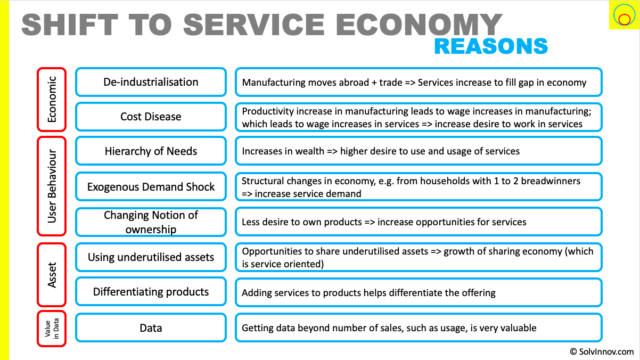
Wrapping Up
So here’s a comparison of the goods-service and service-service continuum.

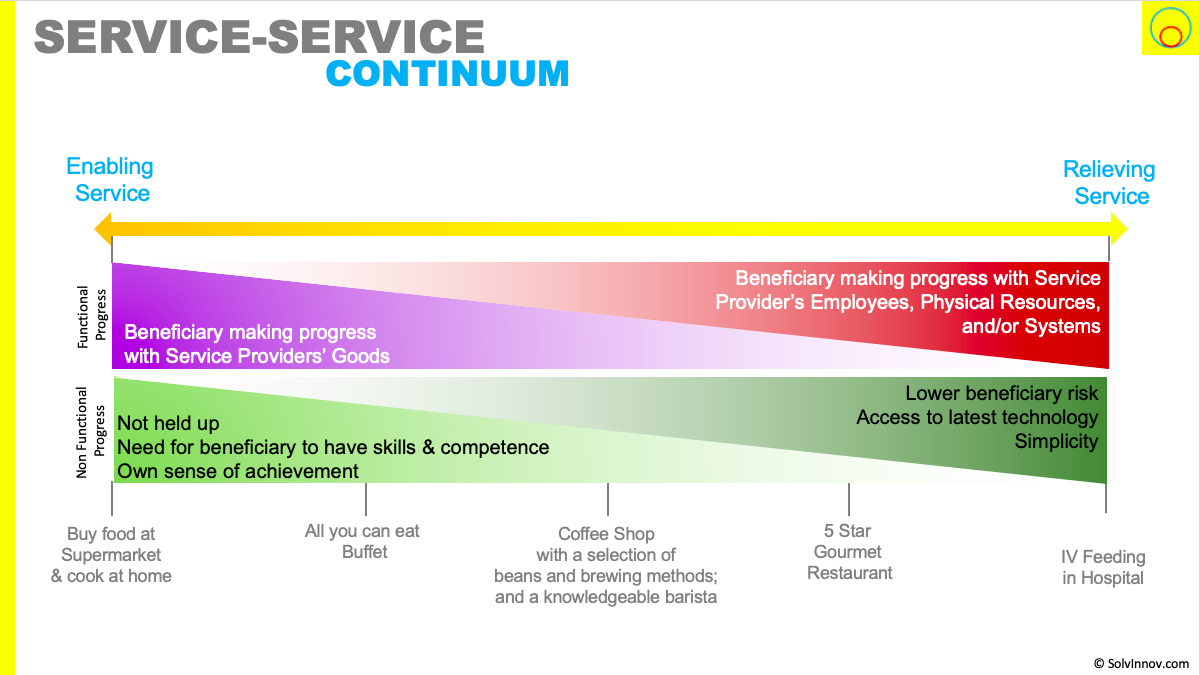
The classic goods-service continuum is not relevant in a service-first world. Whereas my service-service continuum allows us to position new value propositions and understand their implications relating to a value framework that equates value to amount of progress made.
Our first question should always be “what progress am I trying to help a beneficiary make?”. To which we can additionally tease out “how would they like to be helped?” Or, “what balance of enabling and relieving are they seeking?” What skills/competence do we push to the beneficiary to have if we drive a self-service approach? Can we minimise/help that? What level of risk transfer can we help with? Are the beneficiaries looking for simplicity, speed, safety, sense of achievement or more?


